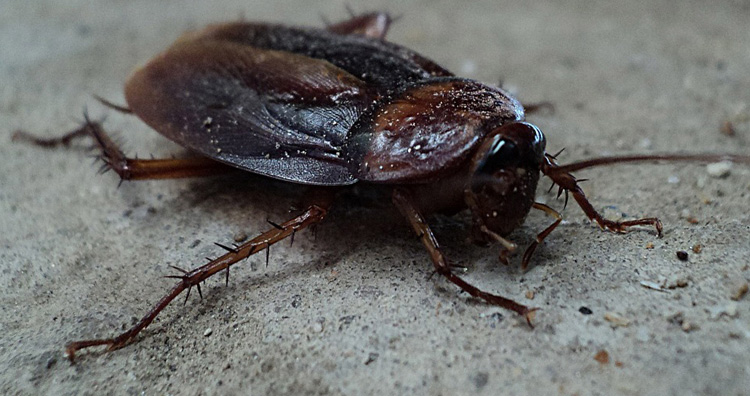There are fun facts, and there is trivia. And then there are spooky facts that will give you sleepless nights and chills for weeks. From seemingly undead spiders and headless cockroaches to missing nuclear weapons and bacterial apocalypse, this list has it all and it only gets spookier as you read down the list. Read on to find out about such spine-chilling facts that we collected from various sources around the web.
1. One in fifty of us is walking around with a brain aneurysm. It just hasn’t ruptured yet.

A brain aneurysm happens when a weak spot in a brain artery swells and gets filled with blood. If this aneurysm ruptures, it fills the surrounding area of the brain with blood. This is called a subarachnoid hemorrhage. This may lead to seizures, paralysis, difficulty in speaking and understanding language or sight, and even death in 30 to 40 % of the cases. It is estimated that approximately six million people in the US have an unruptured brain aneurysm! The Brain Aneurysm Foundation has stated that a person has a brain aneurysm every 18 minutes, and up to 40% of those turn out to be fatal. And out of those who do survive, 66% are saddled with some of the other lasting neurological damage. Unfortunately, there are no distinctive warning signs to indicate its presence or onset. Brain aneurysms cause almost 500,000 deaths globally, and half of them are in people less than 50 years of age. Studies show that aneurysms are most common among people between 35 and 60 years of age, but may occur in children as well. More women suffer from brain aneurysms than men do.(source)
2. Serial killers may be killing ten times more people in the US than was earlier estimated. There could be as many as 1,832 murders that were not taken into account.

Kenna Quinet, a criminologist at Indiana University-Purdue University in Indianapolis, has found out that there is a considerable lack of missing data about murder victims. According to her article in the journal Homicide Studies, this includes the number of people on the fringes of society like prostitutes, transients, street hustlers, foster children, etc. This is not new data. Surprisingly, these people have just never been counted while creating statistics. In lots of cases, the body of victims is never found leading to a miscalculation of the actual number of serial killer victims. One such example is the case of the famous “Green River serial killer,” who was active between 1982 until his capture in 2001. One-third of his “known” 48 victims were never even reported missing or had been erroneously erased from police records of missing persons. Therefore, the figures that you see in the news or other reports may not even come close to the actual number of people murdered by serial killers.(source)
3. The FBI says that being a long-haul trucker is an ideal profession for a serial killer. Right now, there are no less than 25 long-haul truckers in prison for serial killings.

In 2004, an Oklahoma Bureau of Investigation analyst found a pattern of women’s bodies being dumped along the highway going through Oklahoma, Texas, Arkansas, and Mississippi. And the same pattern was found on other roads as well. According to the analysis done by FBI’s Highway Serial Killings Initiative, there have been more than 750 murder victims found along or close to US highways. They have also found 450 possible suspects, and many of them turned out to be truck drivers. They use the opportunity of open roads and anonymity to carry on their killings without fear of being caught. Since they are always on the move, especially at night, and have access to several different areas, it is tough to pin them down.
This should make you pause and think while planning your next big road trip!(source)
4. A cockroach can possibly live up to one month without its head, given that it’s not infected by bacteria or a virus or eaten up by predators. This is so because it does not require the brain to control the breathing process and other basic functions at all.

The cockroach is one stubborn insect. Joseph Kunkel, a physiologist and chemist at the University of Massachusetts Amherst, believes that they can live without their heads for weeks since they have an open circulatory system and don’t have much of a blood pressure. They breathe through small holes in their body segments without the help of blood. So, when the wound on their necks clots and seals off, they have no trouble carrying on with their lives! Cockroaches are also cold-blooded and can live without food for weeks. He also claims that even its decapitated head can survive up to a few hours.(source)
5. We still don’t know whether beheading leads to an instant death.

There are innumerable eyewitness accounts where severed heads show signs of awareness like blinking, movement of lips, change in expression, etc. This phenomenon is called “lucid decapitation.” In 1989, a taxi carrying two passengers crashed into a truck. Of the two friends, one of them was decapitated. The survivor later reported that his friend’s head displayed shock, fright, and finally grief. His eyes moved here and there to his prone body and back to his friend, and he established direct eye contact.
Beheading has been stopped as a mode of execution in most countries because of the lingering suspicion that the decapitated head can still feel pain and retains consciousness. It should be noted that in some cases it doesn’t happen as the victim immediately loses consciousness, while in others it lasted several seconds. This has been observed while experimenting on rats during a study in 2011 at the Radboud University Nijmegen in Netherlands. The rats’ brains were connected to an EEG machine after which they were decapitated. There was electrical activity in the 13- to 100-hertz frequency band in their brains for up to four seconds afterward. This frequency band is linked to mental processes like cognition and consciousness. So, if rats’ brains still work for a few seconds after being beheaded, is it too far-fetched to assume that the same happens with humans?(1,2)
6. Spiders can apparently survive underwater for hours by entering a coma. Scientists were shocked when they saw “dead” spiders come back to life in their lab.

In 2009, scientists at the University of Rennes in France were conducting an experiment to see how long spiders survive underwater before actually drowning. They collected 120 females of three different species of wolf spiders and put them in seawater. They all died in 24, 28, and 36 hours. The scientists took them out and laid them out to dry to be weighed later. A couple of hours later, they all came back wriggling to life! It was deduced that the spiders hadn’t actually died from drowning, but had gone into a coma by switching to metabolic processes that don’t need them to breathe. The lead researcher, Julien Pétillon, believes that there could be other insect or animal species who exhibit the same defense mechanism while drowning, but we just don’t know of them yet.(source)
7. There was a woman that had a “mummified baby” in her body for 46 years until she learned it was there.
This is an extremely rare phenomenon called “lithopedion” (stone baby in Ancient Greek). It happens when a fetus dies during the pregnancy but it too big to be reabsorbed. It then calcifies from outside to shield the mother from dead tissue and infections. It can happen any time after 14 weeks, and possibly remain undiscovered for decades.
There are only 300 reported cases of lithopedion in the world. The earliest one dates back to the late tenth century, and the latest one happened in 2011. One woman, at the age of 75, had had it for 46 years before going to the doctor thinking she had an ovarian tumor. The longest known case is that of Huang Yijun, who had it for 65 years. It was discovered in 2013. Her fetus had died in 1948, and she had no money for an abortion.(source)
8. Grizzly bears can run more than 60 kph or 34.8 mph. That they can’t move fast because of their weight or can’t run downhill are both myths.

They can run twice as fast as humans and can even beat a racehorse in a short distance. In spite of their lumbering body and weight, their incredible muscle strength helps them run fast. Additionally, they run on four legs and their claws help too. Luckily, they don’t have much endurance. However, this fact won’t help you if ever a bear decides to chase you. Usain Bolt’s record is 27.8 mph, and if he can’t outrun a grizzly, you and I definitely can’t.(1,2,3)
9. An apocalypse due to a fatal bacterial disease may not just be the stuff of sci-fi movies. Bacteria are increasingly becoming more resistant to antibiotics, and one day there will be a resilient bacterial disease that will lay waste to a huge chunk of the population.

This global resistance to antibiotics is actually happening right now all over the world. When bacteria changes, the antibiotics that people take to treat their infections will not work any longer. When this happens, even common ailments will not be affected by antibiotics making them a serious threat to public health. A WHO report in 2014 revealed that they have observed antibiotic resistance in seven bacteria that cause sepsis, diarrhea, pneumonia, gonorrhea, and urinary tract infections.(source)
10. It’s actually no big deal to have ten insects and 35 fruit fly eggs in every eight pounds of raisins, according to FDA regulations.

The FDA has an actual list of permissible “natural contaminants” in our food. This includes insects, bugs, mold, rodent hair, maggots, mammalian excreta, rot, insect eggs, mildew and even foreign matter which can be just about anything! Tomato juice is allowed to have ten or more fly eggs per ten grams, or five or more eggs and one or more maggots. Canned mushroom can have more than 20 maggots of any size in a 100-gram pack. Peanut butter is allowed 145 bug parts, or five rodent hairs, or 125 milligrams grit for every 18-pound jar! And the list goes on. The average American probably ends up unknowingly eating up to two pounds of flies, mites, and maggots every year.(source)
11. It is estimated that at least 40 nuclear warheads have been lost since the Cold War.

These are called Broken Arrows, which is “an unexpected event involving nuclear weapons that result in the accidental launching, firing, detonating, theft, or loss of the weapon.”
The US Department of Defense has reported 32 accidents involving nuclear weapons between 1950 and 1980. Out of these, at least seven were never found, and they were reportedly 2,200 times more explosive than the Hiroshima bomb! A plane disappeared over the Mediterranean Sea into thick clouds in 1956 and could never be traced again. It had two nuclear weapon cores as cargo. In 1965, on the USS Ticonderoga, a Skyhawk carrying a hydrogen bomb simply rolled off the deck and into the ocean which at that point was 16,000 feet deep. The US army finally disclosed this incident 15 years later claiming that it was 500 miles into the sea, whereas it happened only 80 miles away from Ryuku Island.
In October 1986, a Russian nuclear-powered submarine sank 480 miles off the coast of Bermuda. There was a failure onboard which led to seawater mixing with fuel which caught fire. It allegedly had 34 nuclear weapons onboard at the time.











No comments:
Post a Comment